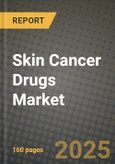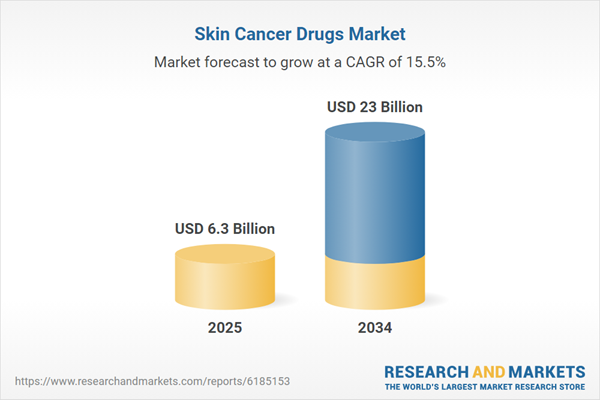The skin cancer drugs market plays a critical role in the global fight against rising cases of skin malignancies, including basal cell carcinoma, squamous cell carcinoma, and the more aggressive melanoma. Driven by factors such as increased UV exposure, aging populations, and heightened awareness about early detection, demand for effective treatments continues to grow. Therapeutic options range from chemotherapy and immunotherapy to targeted therapies and topical agents, with an increasing shift toward precision medicine that caters to individual tumor genetics. Pharmaceutical companies are focusing heavily on drug innovation, especially in immuno-oncology and biologics, as patients and clinicians seek therapies with better efficacy and fewer side effects. The market is supported by ongoing clinical research, governmental cancer control initiatives, and patient advocacy groups that promote early diagnosis and equitable access to care. Despite progress, disparities in treatment availability and affordability persist, particularly in low- and middle-income countries, where access to advanced skin cancer drugs remains limited.
The skin cancer drugs market witnessed noteworthy developments in targeted therapy approvals and clinical pipeline advancements. Several new-generation immunotherapy drugs entered late-stage trials, especially PD-1 and CTLA-4 inhibitors showing promising results in treating advanced melanoma. The FDA and other regulatory agencies approved additional indications for existing drugs, expanding their use in earlier stages of skin cancer and for patients with specific genetic markers. Pharmaceutical companies emphasized combination therapies to overcome resistance mechanisms, leading to collaborations between biotech firms and oncology research centers. Topical therapies for non-melanoma skin cancers also gained popularity, offering non-invasive options for early-stage treatment. Meanwhile, artificial intelligence began to play a role in drug discovery and patient response prediction, shortening development timelines. Globally, patient access initiatives gained momentum as governments partnered with manufacturers to subsidize life-saving cancer treatments. These combined efforts helped improve survival outcomes while fostering optimism for future breakthroughs in dermatologic oncology.
The skin cancer drugs market is expected to experience sustained innovation and market expansion. Drug developers are anticipated to explore bispecific antibodies and cancer vaccines tailored to specific tumor antigens, with a focus on improving immune system engagement. Oral formulations and subcutaneous injections are also likely to gain ground as patient-friendly alternatives to traditional intravenous infusions. With advancements in companion diagnostics, treatment protocols will become increasingly personalized, enabling oncologists to match patients with the most effective therapy based on genetic profiles. Digital health technologies, including wearable biosensors and remote monitoring tools, will support treatment adherence and enhance long-term care management. Global market penetration will continue to grow, particularly as health systems in emerging economies invest more in oncology infrastructure. However, the rising cost of novel therapies poses a major challenge, pressuring stakeholders to find a balance between innovation and affordability through pricing reform, biosimilars, and expanded access programs.
Key Insights: Skin Cancer Drugs Market
- Immunotherapy Advancements: Immune checkpoint inhibitors targeting PD-1, PD-L1, and CTLA-4 continue to dominate the treatment landscape, with new combinations and next-gen molecules showing improved survival outcomes in advanced melanoma cases.
- Personalized Medicine Growth: The rise of precision oncology is enabling tailored treatment plans using genetic profiling and biomarker identification, improving efficacy and reducing unnecessary exposure to ineffective drugs.
- Topical and Non-Invasive Therapies: Increased development of topical agents and creams is offering safer alternatives for non-melanoma cases, particularly among elderly or surgery-averse patients seeking localized treatments.
- AI in Drug Discovery: Artificial intelligence is streamlining drug development by identifying novel targets, predicting patient response, and accelerating clinical trial design in both early and late-stage drug pipelines.
- Expanded Indication Approvals: Regulatory bodies are approving skin cancer drugs for broader use, including earlier disease stages and new genetic subtypes, expanding the eligible patient pool for life-extending therapies.
- Rising Incidence of Skin Cancer: Increased sun exposure, tanning habits, and an aging global population are driving higher skin cancer diagnoses, creating consistent demand for effective and diverse treatment options.
- Improved Diagnostic Capabilities: Advances in skin cancer screening, such as dermatoscopy and digital imaging, are enabling earlier diagnosis and driving demand for treatments that can be initiated at less advanced stages.
- Government and NGO Initiatives: Public health campaigns and partnerships between governments and non-profits are raising awareness, improving access to early treatment, and boosting investments in cancer drug development.
- Investment in R&D and Biotech Innovation: Pharmaceutical and biotech firms are prioritizing skin cancer within their oncology pipelines, allocating resources to explore novel immunotherapies, targeted agents, and biologics.
- High Cost of Novel Therapies: Innovative skin cancer drugs often come with substantial price tags, raising concerns over affordability and access, particularly in developing regions where insurance coverage or public funding is limited.
Skin Cancer Drugs Market Segmentation
By Type
- Actinic Keratoses (AK)
- Basal cell carcinoma (BCC)
- Squamous cell carcinoma (SCC)
- Melanoma
By Drug Class
- Chemotherapy
- Immunotherapy
- Targeted Agents & Other Drugs
By End Users
- Hospitals
- Cancer Research Centers
- Clinics
Key Companies Analysed
- Pfizer Inc.
- Meda Pharmaceuticals
- Roche Holding AG
- Merck & Co. Inc.
- AbbVie Inc.
- Novartis International AG
- Sanofi SA
- Bristol Myers Squibb Company
- AstraZeneca PLC
- GlaxoSmithKline plc
- Takeda Pharmaceutical Company Limited
- Eli Lilly and Company
- Boehringer Ingelheim International GmbH
- Mylan N.V.
- Daiichi Sankyo Company Limited
- Bausch Health Companies Inc.
- Valeant Pharmaceuticals
- Sun Pharmaceutical Industries Ltd
- Ipsen Pharma
- Varian Medical Systems Inc.
- Kyowa Kirin Co. Ltd.
- QIAGEN N.V.
- Elekta AB
- Cannabis Science Inc.
- LEO Pharma A/S
- Aqua Pharmaceuticals
- iCAD Inc.
- AB Science
- Cellceutix Corporation
- Eisai Co. Ltd.
- Otsuka Pharmaceutical Co. Ltd.
- Seattle Genetics Inc.
Skin Cancer Drugs Market Analytics
The report employs rigorous tools, including Porter’s Five Forces, value chain mapping, and scenario-based modeling, to assess supply-demand dynamics. Cross-sector influences from parent, derived, and substitute markets are evaluated to identify risks and opportunities. Trade and pricing analytics provide an up-to-date view of international flows, including leading exporters, importers, and regional price trends.Macroeconomic indicators, policy frameworks such as carbon pricing and energy security strategies, and evolving consumer behavior are considered in forecasting scenarios. Recent deal flows, partnerships, and technology innovations are incorporated to assess their impact on future market performance.
Skin Cancer Drugs Market Competitive Intelligence
The competitive landscape is mapped through proprietary frameworks, profiling leading companies with details on business models, product portfolios, financial performance, and strategic initiatives. Key developments such as mergers & acquisitions, technology collaborations, investment inflows, and regional expansions are analyzed for their competitive impact. The report also identifies emerging players and innovative startups contributing to market disruption.Regional insights highlight the most promising investment destinations, regulatory landscapes, and evolving partnerships across energy and industrial corridors.
Countries Covered
- North America - Skin Cancer Drugs market data and outlook to 2034
- United States
- Canada
- Mexico
- Europe - Skin Cancer Drugs market data and outlook to 2034
- Germany
- United Kingdom
- France
- Italy
- Spain
- BeNeLux
- Russia
- Sweden
- Asia-Pacific - Skin Cancer Drugs market data and outlook to 2034
- China
- Japan
- India
- South Korea
- Australia
- Indonesia
- Malaysia
- Vietnam
- Middle East and Africa - Skin Cancer Drugs market data and outlook to 2034
- Saudi Arabia
- South Africa
- Iran
- UAE
- Egypt
- South and Central America - Skin Cancer Drugs market data and outlook to 2034
- Brazil
- Argentina
- Chile
- Peru
Research Methodology
This study combines primary inputs from industry experts across the Skin Cancer Drugs value chain with secondary data from associations, government publications, trade databases, and company disclosures. Proprietary modeling techniques, including data triangulation, statistical correlation, and scenario planning, are applied to deliver reliable market sizing and forecasting.Key Questions Addressed
- What is the current and forecast market size of the Skin Cancer Drugs industry at global, regional, and country levels?
- Which types, applications, and technologies present the highest growth potential?
- How are supply chains adapting to geopolitical and economic shocks?
- What role do policy frameworks, trade flows, and sustainability targets play in shaping demand?
- Who are the leading players, and how are their strategies evolving in the face of global uncertainty?
- Which regional “hotspots” and customer segments will outpace the market, and what go-to-market and partnership models best support entry and expansion?
- Where are the most investable opportunities - across technology roadmaps, sustainability-linked innovation, and M&A - and what is the best segment to invest over the next 3-5 years?
Your Key Takeaways from the Skin Cancer Drugs Market Report
- Global Skin Cancer Drugs market size and growth projections (CAGR), 2024-2034
- Impact of Russia-Ukraine, Israel-Palestine, and Hamas conflicts on Skin Cancer Drugs trade, costs, and supply chains
- Skin Cancer Drugs market size, share, and outlook across 5 regions and 27 countries, 2023-2034
- Skin Cancer Drugs market size, CAGR, and market share of key products, applications, and end-user verticals, 2023-2034
- Short- and long-term Skin Cancer Drugs market trends, drivers, restraints, and opportunities
- Porter’s Five Forces analysis, technological developments, and Skin Cancer Drugs supply chain analysis
- Skin Cancer Drugs trade analysis, Skin Cancer Drugs market price analysis, and Skin Cancer Drugs supply/demand dynamics
- Profiles of 5 leading companies - overview, key strategies, financials, and products
- Latest Skin Cancer Drugs market news and developments
Additional Support
With the purchase of this report, you will receive:- An updated PDF report and an MS Excel data workbook containing all market tables and figures for easy analysis.
- 7-day post-sale analyst support for clarifications and in-scope supplementary data, ensuring the deliverable aligns precisely with your requirements.
- Complimentary report update to incorporate the latest available data and the impact of recent market developments.
This product will be delivered within 1-3 business days.
Table of Contents
Companies Mentioned
- Pfizer Inc.
- Meda Pharmaceuticals
- Roche Holding AG
- Merck & Co. Inc.
- AbbVie Inc.
- Novartis International AG
- Sanofi SA
- Bristol Myers Squibb Company
- AstraZeneca PLC
- GlaxoSmithKline PLC
- Takeda Pharmaceutical Company Limited
- Eli Lilly and Company
- Boehringer Ingelheim International GmbH
- Mylan N.V.
- Daiichi Sankyo Company Limited
- Bausch Health Companies Inc.
- Valeant Pharmaceuticals
- Sun Pharmaceutical Industries Ltd.
- Ipsen Pharma
- Varian Medical Systems Inc.
- Kyowa Kirin Co. Ltd.
- QIAGEN N.V.
- Elekta AB
- Cannabis Science Inc.
- LEO Pharma A/S
- Aqua Pharmaceuticals
- iCAD Inc.
- AB Science
- Cellceutix Corporation
- Eisai Co. Ltd.
- Otsuka Pharmaceutical Co. Ltd.
- Seattle Genetics Inc.
Table Information
| Report Attribute | Details |
|---|---|
| No. of Pages | 160 |
| Published | October 2025 |
| Forecast Period | 2025 - 2034 |
| Estimated Market Value ( USD | $ 6.3 Billion |
| Forecasted Market Value ( USD | $ 23 Billion |
| Compound Annual Growth Rate | 15.4% |
| Regions Covered | Global |
| No. of Companies Mentioned | 32 |









